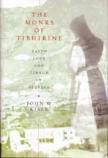Inshallah!
The story of seven men who literally lost their heads for Christor more accurately for their fellow humans whom they selflessly loved in Christis one of heroic beauty. And John W. Kiser tells it in full. The Monks of Tibhirine (the author’s third book, after Communist Entrepreneurs and Stefan Zweig: Death of a Modern Man) is an especially valuable book to read in this present moment in history for the profoundly insightful and compassionate way in which the author puts this martyrdom in context.
During the night of March 27-28, 1996, an armed band of Islamic fundamentalists broke through the gates and into the Cistercian Monastery of Our Lady of Atlas near the village of Tibhirine in Algeria, abducted seven monks and subsequently executed them. Father Christian de Chergé, the superior, was a man with an extraordinarily compassionate heart, and he sought to help each of his brother monks cultivate the same. He succeeded. Christian, and even more his Trappist brothers Bruno, Christophe, Luc, Paul, Michael and Celestin, were ordinary men. As they marched steadfastly toward their foreseen fate, they continued to perform their everyday, very ordinary tasks in loving fraternity and service to their Muslim neighbors. It took many meetings for them to arrive at their heroic solidarity and support one another in it. Most of them had been touched at some time in earlier life by the beauty of Algiers and the goodness of the ordinary Algerian.
The seven monks of Our Lady of Atlas came from different backgrounds. And different things brought them to the cloisters of one of the strictest orders in the church, the Cistercian Trappists, then led them further to seek out one of the smallest and poorest monasteries in the order, this little house in Algeria. A love beyond human telling brought them into a communion (if I may use that word) with their fellow humans that in many ways erased the barriers of religion.
Kiser’s book is not heavy; in fact, it is an easy and enjoyable read. Yet anyone looking for a good summation of the history of the Trappists through the centuries and through the vicissitudes of post-Vatican II renewal will not be disappointed. Kiser captures the spirit and the very down-to-earth way this life was lived at Tibhirine, what he calls the dualities of Trappist life: solitude and community, meditation and action, love and discipline, a community-disciplined and self-disciplined life. At the same time, he also presents Islam in its richness and depth and the historical vicissitudes it has experienced in Algiers through the centuries and in the evolution of the new Muslim nation.
I have read a number of books on Islam during recent months, profoundly aware of my ignorance in regard to this great world religion. But no book I read gave me as much of a feeling for these brothers and sisters as has Kiser’s account of the monks of Tibhirine. For this alone, it is a book we can very profitably read under the present circumstances.
Christian, the unifier, is an especially attractive figure who holds center stage in the narrative: [H]e always chose to see the good in things, to look beyond the irritants and the bad. He did not want to dignify evil by letting it preoccupy him. Nor would he make broad judgments about people or governments. He would merely describe a specific act as good or bad, helpful or unhelpful, according to the situation. He believed people could always change, especially if one addressed their higher nature. Kiser weaves into his narrative rich, warm portraits of all the other Cistercian martyrs, as well as of a number of the Muslims who touched their lives.
Throughout the book are wonderful words of wisdom, worthy of the greatest of sages: The first words a person’s face says to another is, respect me. The only way for us to give witness is to live what we do, and be what we are in the midst of banal, everyday realities. If redemption is the motive for the coming of Christ, then Incarnation is the method. Killing can take different forms as all who live in community know. A contemptuous attitude, a wounding word, phrases that assassinate are other ways to kill. Christians are not the only martyrs of charity. Muslims are, too.
This volume also includes the Testament of Christian de Chergé, which undoubtedly will take its place as one of the spiritual classics of the 20th century. This deeply moving document, written less than three years before he was martyred (but by his request not opened until after his death), concludes with this word to his executioner:
And to you, too, my friend of the last moment, who will not know what you are doing. Yes, for you, too, I wish this thank you, this A-Dieu, whose image is in you also, that we may meet in heaven, like happy thieves, if it pleases God, our common Father. Amen! Insha Allah!
John Kiser has done his homework. The interesting notes at the end of the book prove it. There is also a most useful glossary of termsvery helpful for those unfamiliar with Islamas well as a chronology of the main events marking the history of Algeria and a bibliography.
After reading The Monks of Tibhirine, it is clear that Father Christian cultivated a like compassion in the writer John Kiser, who came to know the monk and his people in the course of his extensive research.
This article also appeared in print, under the headline “Inshallah!,” in the April 8, 2002, issue.








